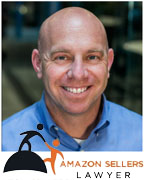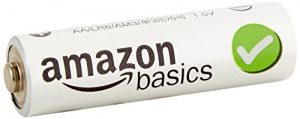What to Expect from the Amazon Marketplace in 2017

It was another big year for Amazon in 2016, which continues to grow its revenue and valuation annually. Amazon was able to maintain its dominance as the top internet retailer in the ecommerce space while growing its overall market share among all retailers (digital/B&M).
It’s difficult to believe Amazon’s growth won’t continue into 2017. A hugely successful Prime Day boosted Prime membership sign-ups and mid-year sales. With Prime Memberships rapidly increasing and new product offerings through AmazonBasics, privately-owned labels, and Echo/Alexa, we don’t really expect Amazon to slow down.
Last year we asked leading industry experts what sellers should look for in the Amazon marketplace going into 2016, and we decided to redo the concept for 2017.

Pat Petriello, Senior Marketplace Strategist at CPC Strategy
Pat Petriello is a former professional seller on Amazon.com, Amazon.co.uk, eBay, Buy.com and former member of Amazon Seller Service Team. He now leads the Amazon Department at CPC Strategy.
Greg Mercer, CEO of Jungle Scout
Greg Mercer is the Founder and CEO of Jungle Scout, an online producer of digital tools for Amazon product research. Since being initially designed as a Chrome Extension, Jungle Scout has grown to offer a full suite of products targeted at equipping sellers with the tools needed to make data-driven decisions that help identify product opportunities.

Nick Sandberg, Lead Marketplace Channel Analyst, CPC Strategy
Nick Sandberg is a Lead Marketplace Channel Analyst for CPC Strategy with a focus on management, marketing, consulting, and research in the rapidly evolving digital marketplace.
Carina McLeod, Amazon Retail Specalist and eCommerce Management Consultant, eCommerce Nurse
Carina spent over 7 years working at Amazon within Retail and Vendor Management, launching Sports & Fitness, Watches and Apparel into the UK market. After her time at Amazon, Carina launched an online store in Costa Rica and set up her own consultancy business where she has spent the last 3 years supporting and managing Sellers and Vendors in growing their businesses on Amazon.

Joe Selzer, Marketplace Channel Analyst at CPC Strategy
Joe Selzer is an expert Marketplace Channel Analyst at CPC Strategy. He analyzes key metrics and implements data-driven strategy across marketing campaigns, inventory management, pricing, fulfillment strategy, product management, content management, feedback solicitation/maintenance, and CRM.
Chad Rubin, Co-Founder & CEO of Skubana; Founder of Crucial Vacuum
Having worked in corporate finance covering internet stocks, Chad Rubin decided in 2008 to set up an e-commerce storefront, CrucialVacuum.com, and later an e-commerce acceleration platform, Skubana. Skubana is an enterprise-grade, all-in-one cloud portal that solves the most serious problems of order processing and inventory management. It is scalable enough to accommodate small, medium AND enterprise e-commerce companies, all for a fraction of the cost.

Bernie Thompson, President, Founder, Efficient Era
Bernie Thompson is the founder of Plugable Technologies, which was started a few miles from the house where Jeff Bezos started Amazon. In 2016, he released Plugable’s in-house software to help automate selling on Amazon, and made it available to all sellers. See http://efficientera.com/ for details on all the available tools.
 Paul Johnson, Co-Founder, Seller Labs
Paul Johnson, Co-Founder, Seller Labs
Paul Johnson has leveraged his strengths to help create three successful internet companies. The most recent, Seller Labs, is a software company focused on e-commerce which develops applications for modern e-commerce business. They currently specialize in helping brands build their reputation on marketplaces like Amazon.

Cory (CJ) Rosenbaum, Amazon Sellers Lawyer
C.J. began his interaction with the tech industry back in 1994 when he became a member of the New York New Media Association (NYNMA). Since opening his legal practice, he has focused on representing both online and brick & mortar selling entrepreneurs. While having represented enterprise-level clients in a number of industries, CJ now also offers legal advice for Amazon sellers.
 Jeff Cohen, Director of Business Development, Seller Labs
Jeff Cohen, Director of Business Development, Seller Labs
Jeff joined Seller Labs in 2014 as the Director of Business Development, where he is charged with assisting Amazon sellers develop a brand and build their presence on the world’s largest shopping platform.
We asked the experts: “What three trends do you predict influencing the Amazon Marketplace in 2017 and how can Amazon sellers prepare for these changes?”
 “Geographic Expansion: From 2011 to 2013, Amazon quickly expanded the geographic reach of their programs for 3rd party sellers. Marketplace and FBA quickly went from USA-focused to globally-focused — spanning North America, Europe, and Japan.
“Geographic Expansion: From 2011 to 2013, Amazon quickly expanded the geographic reach of their programs for 3rd party sellers. Marketplace and FBA quickly went from USA-focused to globally-focused — spanning North America, Europe, and Japan.
However, the past few years Amazon has got stuck in a bit of a quagmire in China and India — you could say it’s like a snake trying to digest a panda and an elephant.
Efforts in China continue, but they don’t look healthy, especially considering the headwinds against non-Chinese companies there. India continues to have difficult regulatory barriers, but looks to be a more competitive playing field. Amazon is doubling down there and doing better.
For 2017 and beyond, Amazon seems likely to clear the blockage and begin seeking out new worlds and new civilizations. Public news reports have Amazon hunting for warehouse space in Australia; and perhaps even some countries that would seem poorly matched because of their high import duties and protective customs, such as Brazil where public reports show Amazon having one warehouse already. .
Sellers would be wise to jump on each of these new opportunities, keeping watch for country-specific tax and regulatory burdens that could kill the deal.”
– Bernie Thompson, Efficient Era
 “Cross Border Sales: The world of eCommerce has fueled cross border trade. With retailers such as Amazon allowing international sellers and logistics companies to offer international door to door services, the process of selling international is less daunting and more incentivizing these days.
“Cross Border Sales: The world of eCommerce has fueled cross border trade. With retailers such as Amazon allowing international sellers and logistics companies to offer international door to door services, the process of selling international is less daunting and more incentivizing these days.
With access to new markets and the ability to test the water with minimal risk using companies like Amazon, more and more sellers are expanding their businesses internationally.
On Amazon.com alone sellers have the option to export their US FBA listings to international customers in over 70 countries. They can also sell directly in Canada and Mexico via their North American unified account. For those sellers who want to venture further, the ability to have a unified account in Europe has been a big incentive for international sellers.
A US seller can now set up one account–for example in the UK–and then under that one account be able to list their items in Germany, France, Italy and Spain. They can then store their inventory in one country, or all of them, and take advantage of the different European FBA programs Amazon offers.
Of course, cross-border selling does come with a series of challenges and considerations. Sellers need to take into account the different currencies, languages, legislation, international shipping, localization and taxes. However, if sellers are still curious after taking into accounting all of these challenges, why not test the water?”
– Carina McLeod, eCommerce Nurse
 “Explosive Growth of Chinese Merchants: Chinese sellers on Amazon will grow exponentially in 2017. Amazon is aggressively recruiting Chinese merchants to Amazon. Dragon Boat, a program started by Amazon, provides an easy way for Chinese sellers to get inventory from China into FBA. Amazon has also given Chinese sellers special privileges like dedicated account managers. Every Amazon merchant needs to develop a strategy to compete with the influx of new sellers. Developing a fine-tuned marketing and branding strategy will be the key to standing out in 2017.”
“Explosive Growth of Chinese Merchants: Chinese sellers on Amazon will grow exponentially in 2017. Amazon is aggressively recruiting Chinese merchants to Amazon. Dragon Boat, a program started by Amazon, provides an easy way for Chinese sellers to get inventory from China into FBA. Amazon has also given Chinese sellers special privileges like dedicated account managers. Every Amazon merchant needs to develop a strategy to compete with the influx of new sellers. Developing a fine-tuned marketing and branding strategy will be the key to standing out in 2017.”
– Paul Johnson, Seller Labs
 “More Amazon revenue streams are available across the world. Go get them: After the United States market, know who the second largest amazon marketplace is? Europe, which encompasses Amazon.de, Amazon.co.uk, Amazon.fr, Amazon.es, and Amazon.it.
“More Amazon revenue streams are available across the world. Go get them: After the United States market, know who the second largest amazon marketplace is? Europe, which encompasses Amazon.de, Amazon.co.uk, Amazon.fr, Amazon.es, and Amazon.it.
Does a potential market of 300 million more shoppers appeal to you as a seller? Once your ducks are in a row and potentially a 3PL provider located and ready to receive your goods in the market country, you have only to follow a short “to-do” list of actionables in order to take advantage of this massive opportunity:
– Chad Rubin, Skubana
 “As people become more accustomed to purchasing everyday items online the Amazon Prime program will continue its rapid growth.
“As people become more accustomed to purchasing everyday items online the Amazon Prime program will continue its rapid growth.
Along with the increased desire for 2 day shipping, Amazon Fresh, Prime Pantry, Amazon Original TV Series, Amazon Music Unlimited, and additional benefits (yet to be announced) to the total Prime offering will further grow the popularity and attractiveness of a $99 a year Prime membership.
This increase of customers will be equally matched by an influx of sellers to the Amazon marketplace seeking access to the growing base of Prime customers. The pace at which Amazon will be able to construct fulfillment centers will not be able to keep up with this demand. Thus, we will see emphasis placed on encouraging sellers with their own fulfillment capabilities to enroll in Seller Fulfilled Prime and perhaps even a loosening of requirements to join that program.
Additionally fees associated with using the popular FBA service will continue to increase throughout the course of the year as space in Amazon’s Fulfillment centers is increasingly impacted.”
– Nick Sandberg, CPC Strategy
 “Seller-Fulfilled Prime: One of the key motivators for sellers to sell via Fulfilment by Amazon (FBA) is the fact that their items will become Prime eligible. With more than half of Amazon’s customer base in the US a Prime member, sellers cannot maximize their sales potential without having a Prime offering. Despite FBA making listings Prime eligible, this avenue is not always viable for every seller. Some sellers may not want to lock up their inventory in Amazon’s Fulfilment Centers, have products with a low sales turnover or list large, heavy items that cost too much to store.
“Seller-Fulfilled Prime: One of the key motivators for sellers to sell via Fulfilment by Amazon (FBA) is the fact that their items will become Prime eligible. With more than half of Amazon’s customer base in the US a Prime member, sellers cannot maximize their sales potential without having a Prime offering. Despite FBA making listings Prime eligible, this avenue is not always viable for every seller. Some sellers may not want to lock up their inventory in Amazon’s Fulfilment Centers, have products with a low sales turnover or list large, heavy items that cost too much to store.
In 2015 Amazon started to offer the option of Seller Fulfilled Prime to a select few sellers by invite only. Then in 2016 Amazon began to extend this offer. Seller Fulfilled Prime means that sellers can now be Prime eligible when they fulfill customer orders directly without going through FBA. This is great news for sellers that already have the right logistics in place to offer 2-day shipping, handle returns and manage customer service.
 Sellers should be able to see cost savings by not having to double ship; send a shipment to Amazon Fulfilment Center and then ship the product to the customer. They will also have control over their own stock and product returns. Questions are often raised about the handling of products in the Fulfilment Center and how stock gets damaged, as well as how returns are managed. By sellers controlling their own stock, they should eliminate a number of these issues.
Sellers should be able to see cost savings by not having to double ship; send a shipment to Amazon Fulfilment Center and then ship the product to the customer. They will also have control over their own stock and product returns. Questions are often raised about the handling of products in the Fulfilment Center and how stock gets damaged, as well as how returns are managed. By sellers controlling their own stock, they should eliminate a number of these issues.
Being eligible to list items via Seller Fulfilled Prime is not easy. Amazon has a certain number of requirements that sellers must adhere to, as well as have long standing, excellent performance metrics. If a seller is interested in this program, they need to check they are eligible and that they can adhere to all Amazon’s requirements.
I believe that Seller Fulfilled Prime is a new initiative that Amazon will be pushing more heavily in 2017. I always think to myself, how much more FBA stock can Amazon really hold? Will they keep opening up more Fulfilment Centers or is Seller Fulfilled Prime the new solution? I am excited to see how this program will evolve over the next coming years.”
– Carina McLeod, eCommerce Nurse
 “Better FBA strategy is crucial: We saw several signs in 2016 indicating that Amazon Fulfillment Center space is not as limitless as many envisioned. Amazon increased storage fees during the holidays, pushed hard for more Dropship
“Better FBA strategy is crucial: We saw several signs in 2016 indicating that Amazon Fulfillment Center space is not as limitless as many envisioned. Amazon increased storage fees during the holidays, pushed hard for more Dropship
Vendors, increased limitations around which products can be pushed through AMS and Vendor Powered Promotions, and even blocked Sellers from entering into a new FBA relationship during Q4. These were just a few of the signs and although the e-tail giant is working hard to build more FC’s, I believe the pace of new Sellers and products arriving on the Marketplace is impressing even them.
The best way for Sellers to prepare for this is to make sure they have a clear, data-driven FBA inventory strategy and aren’t just throwing product at Amazon based on hunches. Expect Amazon to continue to implement measures that reward Sellers for managing inventory well (and ding Sellers for sloppy inventory management).
By managing it well, I mean keeping it relatively lean – Amazon doesn’t want to hold stock any longer than they have to, and ideally a new inventory shipment would arrive as soon as a product stocked out. Helping Amazon towards this goal (without sacrificing sales) will pay dividends in 2017.”
– Joe Selzer, CPC Strategy
 “One trend I expect we will continue to see is Amazon expanding their existing line of private label products. In 2016, they launched multiple private label brands in the perishable food, baby, and apparel categories which included Happy Belly, Wickedly Prime, Mama Bear, Franklin & Freeman, and North Eleven, among others. They’ve also continued to add selection to their AmazonBasics line as well as their Pinzon and Element brands, which have been available on the Marketplace for years.
“One trend I expect we will continue to see is Amazon expanding their existing line of private label products. In 2016, they launched multiple private label brands in the perishable food, baby, and apparel categories which included Happy Belly, Wickedly Prime, Mama Bear, Franklin & Freeman, and North Eleven, among others. They’ve also continued to add selection to their AmazonBasics line as well as their Pinzon and Element brands, which have been available on the Marketplace for years.
 Amazon has unparalleled customer data to leverage in determining where market opportunities exist, what searches are not being satisfied, and where customers are looking for value. By expanding their private label offerings in high margin verticals, they can use this data to test out new product offerings while limiting exposure to their core Amazon brand.
Amazon has unparalleled customer data to leverage in determining where market opportunities exist, what searches are not being satisfied, and where customers are looking for value. By expanding their private label offerings in high margin verticals, they can use this data to test out new product offerings while limiting exposure to their core Amazon brand.
Amazon has already communicated to us that they are moving aggressively in the apparel and grocery categories, and this is another way they can further penetrate those markets.”
– Pat Petriello, CPC Strategy
 “Amazon’s house brands conquer more categories: AmazonBasics is a known category killer. But did you know Amazon has a nuts and coffee brand called “Happy Belly”? You won’t find Amazon’s name anywhere on the package, but yep – it’s them, just like AmazonBasics.
“Amazon’s house brands conquer more categories: AmazonBasics is a known category killer. But did you know Amazon has a nuts and coffee brand called “Happy Belly”? You won’t find Amazon’s name anywhere on the package, but yep – it’s them, just like AmazonBasics.
And check out Lark & Ro for women’s dresses, Mama Bear organic baby food, and Pinzon towels and sheets. All are Amazon house brands. All of them are launched using what Amazon has learned about the market from the rest of the products selling on Amazon — including yours.
Amazon’s well-known strategy is to compete with itself and the world at every level of the business — from low-level service, to integrated marketplace, to branded product, and every layer in-between. It’s only a matter of time before Amazon moves into a nearby business.
Every year, competition with the “house” will affect more product categories. The only question is how level the playing field is, and whether sellers can find ways to differentiate themselves from Amazon’s own offerings.”
– Bernie Thompson, Efficient Era
 “This is not exactly going out on a limb, but I expect we’ll see continued consolidation in the Marketplace and the reduction of third party resellers.
“This is not exactly going out on a limb, but I expect we’ll see continued consolidation in the Marketplace and the reduction of third party resellers.
Between buy box competition directly from manufacturers (either as 3P’s or Vendors), Amazon commission fees, paid advertising, FBA fees, and product marketing, the financial model for resellers continually gets more untenable without significant volume and reliable inventory of high quality products.
The 40th most competitive offer for a given ASIN does not add any value to the consumer and doesn’t enrich the Marketplace experience in any way. This doesn’t mean that private label products no longer have a place, but it means that the “wild west” days of launching a product of average quality and expecting it to perform are waning.
Amazon is engineering much of their Marketplace optimizations and tool functionality towards brands and manufacturers, meaning the long term opportunity for resellers is shrinking.”
– Pat Petriello, CPC Strategy
 “Amazon 3rd party sellers–nice knowing you: For too long have small third-party sellers on Amazon received a steady profit stream by only selling on the Amazon marketplace. The recent changes made and the rapidly oncoming additional alterations to the comfortable seller model will strike many sellers as subtly as a lightning bolt in a bowl of cereal.
“Amazon 3rd party sellers–nice knowing you: For too long have small third-party sellers on Amazon received a steady profit stream by only selling on the Amazon marketplace. The recent changes made and the rapidly oncoming additional alterations to the comfortable seller model will strike many sellers as subtly as a lightning bolt in a bowl of cereal.
Those in receipt of being “Amazon’d” in this way will have little choice but to find additional streams of revenue through alternate channels as a matter of survival. The gateway drug that is the Amazon marketplace will be yanked away and for those jonesing addicts to explore reseller options like those available at Jet.com, Walmart.com or–heaven forbid–force them to open their own ecommerce website.”
– Chad Rubin, Skubana
 “The marketplace continues to expand: The Amazon marketplace will continue to grow, even on the 3P side. People will continue to do business and make money. The “doom and gloom” is inaccurate, there is no fear of going out of business. Even for sellers doing retail arbitrage, they will be able to continue to buy and sell goods, but should look towards diversifying-don’t buy all one type of product. The skill of this seller is in being able to pick a diverse grouping of products from one place and reselling them.”
“The marketplace continues to expand: The Amazon marketplace will continue to grow, even on the 3P side. People will continue to do business and make money. The “doom and gloom” is inaccurate, there is no fear of going out of business. Even for sellers doing retail arbitrage, they will be able to continue to buy and sell goods, but should look towards diversifying-don’t buy all one type of product. The skill of this seller is in being able to pick a diverse grouping of products from one place and reselling them.”
– CJ Rosenbaum, Amazon Sellers Lawyer
 “I believe Amazon will continue to crack down on counterfeit items, which is going to help brands and private label sellers, but will hurt some resellers, liquidators and retail arbitrageurs. Purchasing inventory from authorized distributors is going to be imperative to the success of resellers.
“I believe Amazon will continue to crack down on counterfeit items, which is going to help brands and private label sellers, but will hurt some resellers, liquidators and retail arbitrageurs. Purchasing inventory from authorized distributors is going to be imperative to the success of resellers.
Amazon will likely start gating even more categories, while removing listings and asking for invoices before it allows merchants to sell again. Developing your own brand or having strong relationships with suppliers is going to be crucial to long-term success on Amazon.”
– Paul Johnson, Seller Labs
 “2017 is an environment where “only the strong survive” on Amazon: 2016 represented an ecommerce “free for all” on Amazon where fake reviews from Alibaba-sourced products from questionable businesses received ranking boosts due to these unscrupulous activities. Now, with the initiation of pay-for-play sponsored ads for impressions and conversions, theoretically the riff raff should be weeded out and off the playing field.
“2017 is an environment where “only the strong survive” on Amazon: 2016 represented an ecommerce “free for all” on Amazon where fake reviews from Alibaba-sourced products from questionable businesses received ranking boosts due to these unscrupulous activities. Now, with the initiation of pay-for-play sponsored ads for impressions and conversions, theoretically the riff raff should be weeded out and off the playing field.
One of the largest factors in this will be the new “Brand Gating” policy that Amazon is initiating to remove 3rd party sellers from selling and representing brands that they are not approved for by the manufacturers or owners of the particular brand. Only the strong will survive and that’s exactly how Amazon wants it.”
– Chad Rubin, Skubana
 “Gated Doesn’t Mean Forbidden: There are some skeptics preaching the idea that sellers should sell everything and get out. Everything is gated now and it’s useless to stay in the game. Look, there are over a billion brands, and Amazon can’t possibly gate them all. As it is, Amazon responds erratically to things anyways.
“Gated Doesn’t Mean Forbidden: There are some skeptics preaching the idea that sellers should sell everything and get out. Everything is gated now and it’s useless to stay in the game. Look, there are over a billion brands, and Amazon can’t possibly gate them all. As it is, Amazon responds erratically to things anyways.
Yes, there will likely be more suspensions going forward, but the process for reinstating brands has improved considerably. We will see suspended accounts to continue to be reinstated at faster rates as Amazon streamlines and improves, minimizing out-of-commission time for sellers.”
– CJ Rosenbaum, Amazon Sellers Lawyer
 “Less saturation, more focused niches/brands: Related to my point on basic marketing tactics, sellers will have to have a more cohesive brand strategy. They cannot choose a random assortment of products to sell just based on a one-off opportunity. Instead, sellers will have to build a brand around core products, and leverage Amazon’s algorithm to get the customer to purchase several items at a time. The goal here is to increase the cart size of each purchase.
“Less saturation, more focused niches/brands: Related to my point on basic marketing tactics, sellers will have to have a more cohesive brand strategy. They cannot choose a random assortment of products to sell just based on a one-off opportunity. Instead, sellers will have to build a brand around core products, and leverage Amazon’s algorithm to get the customer to purchase several items at a time. The goal here is to increase the cart size of each purchase.
Ultimately, there will be a reduction in the number of private label brands that sprout up, and sellers may choose to focus on building their successful brands and let unsuccessful products/brands fall by the wayside. This is again due to Amazon’s October change to incentivized reviews, as it is harder to launch and grow new brands.”
– Greg Mercer, Jungle Scout
 “Market consolidation because of policy changes: Due to the many policy changes in 2016, many merchants will need to reevaluate their Amazon business practices. Many merchants will have a difficult time adapting to changes, which will present an opportunity for competitors and Amazon neophytes. Agile companies will be able to consolidate market share and experience rapid growth in 2017. To stay competitive, more established business will need to move quickly and adapt to the rapidly changing Amazon marketplace.”
“Market consolidation because of policy changes: Due to the many policy changes in 2016, many merchants will need to reevaluate their Amazon business practices. Many merchants will have a difficult time adapting to changes, which will present an opportunity for competitors and Amazon neophytes. Agile companies will be able to consolidate market share and experience rapid growth in 2017. To stay competitive, more established business will need to move quickly and adapt to the rapidly changing Amazon marketplace.”
– Paul Johnson, Seller Labs
 “An area where we saw massive change in 2016 was Amazon taking strides to clean up the Marketplace and restore consumer trust in the Amazon shopper experience. They did this through the introduction of brand gating and the prohibiting of giving products away for free or at a discounted rate in exchange for reviews. Both of these measures are intended to further legitimize the authenticity of the products and product reviews that consumers find on Amazon.
“An area where we saw massive change in 2016 was Amazon taking strides to clean up the Marketplace and restore consumer trust in the Amazon shopper experience. They did this through the introduction of brand gating and the prohibiting of giving products away for free or at a discounted rate in exchange for reviews. Both of these measures are intended to further legitimize the authenticity of the products and product reviews that consumers find on Amazon.
I feel strongly that Amazon is not done in this area and that we’ll see a more transparent and self-service brand gating mechanism as well as aggressive policing of the new product review policy which was put in place in 2016. Alongside this, I expect that we’ll see more top Amazon reviewers make a push to be included as Amazon Vine Voices and more Vendors take advantage of the Amazon Vine program.
We may also see an expansion of the Vine program in terms of greater giveaway limits and more expanded access. Consumer trust is Amazon’s top priority and they will continue to take efforts to mature the Marketplace to protect their own image and the consumer shopping experience.”
– Pat Petriello, CPC Strategy
 “What happens with reviews?: In addition to my three trends, I am also sitting on the edge of my seat waiting to see how the Amazon Vine Program will evolve. With Amazon recently prohibiting incentivized reviews with the exception of Vine, surely the next natural step will be for Amazon to expand this program from being vendor only to being available to sellers. It looks like 2017 may be yet another exciting year on Amazon.”
“What happens with reviews?: In addition to my three trends, I am also sitting on the edge of my seat waiting to see how the Amazon Vine Program will evolve. With Amazon recently prohibiting incentivized reviews with the exception of Vine, surely the next natural step will be for Amazon to expand this program from being vendor only to being available to sellers. It looks like 2017 may be yet another exciting year on Amazon.”
– Carina McLeod, eCommerce Nurse
 “Amazon over-corrects in protecting the integrity of the review system: It took several years for Amazon to notice and take effective steps against the gaming of its review system. But by the end of 2016, Amazon had all guns blazing. Overall, it’s a good thing. The challenge now is in policing these much stricter rules without harming the selling community that is trying to live within them.
“Amazon over-corrects in protecting the integrity of the review system: It took several years for Amazon to notice and take effective steps against the gaming of its review system. But by the end of 2016, Amazon had all guns blazing. Overall, it’s a good thing. The challenge now is in policing these much stricter rules without harming the selling community that is trying to live within them.
Years ago, eBay started suspending and downgrading seller accounts in ways that were capricious and felt unavoidable for most sellers — and in doing so set up the conditions to drive those sellers to the Amazon Marketplace. Amazon is now the company everyone is dependent on, and they too are mechanical about policing their systems. Amazon is now the one that can seem capricious — no warning, little information provided, and not a lot of statistical perspective or account history considered.
But there isn’t another marketplace to jump to in 2017. Walmart’s weeks of paperwork and hand-holding to get started on their platform is indicative of their chance of success. So sellers are going to take the brunt of any over-correction.
In 2017, Amazon will struggle to get rid of sellers gaming the system (it’s still good that they’re trying), but some sellers trying to do the right thing will also be collateral damage. Given these risks everyone will be nervously trying everything they can to diversify off Amazon — and largely failing to do so as Amazon continues to dominate e-commerce in the USA and beyond.”
– Bernie Thompson, Efficient Era
 “A prediction I made for 2016 which will continue into 2017 is Amazon’s expansion and enhancement of their suite of paid advertising modules for Sellers and Vendors on the Marketplace. Specifically, I expect that Amazon will make more granular and customizable reporting available as well as give advertisers additional options when it comes to customer segmenting and targeting.
“A prediction I made for 2016 which will continue into 2017 is Amazon’s expansion and enhancement of their suite of paid advertising modules for Sellers and Vendors on the Marketplace. Specifically, I expect that Amazon will make more granular and customizable reporting available as well as give advertisers additional options when it comes to customer segmenting and targeting.
We’ve seen this already across Sponsored Products, AMS, and even AMG, with Amazon endeavoring to give advertisers more control over where their ads appear and to which customer bases they appear for. Amazon is just scratching the service of the value they can extract from their customer data for empowering advertisers, and as they add functionality  to essentially “catch up” with AdWords, advertisers will be more comfortable investing more heavily in advertising on Amazon.”
to essentially “catch up” with AdWords, advertisers will be more comfortable investing more heavily in advertising on Amazon.”
– Pat Petriello, CPC Strategy
 “The Rise of Sponsored Product Ads: Without product launches focused around generating a surge of reviews, sellers will be more reliant on sponsored ads to get exposure to their products. Moreover, Amazon will continue to augment its advertising platform to track and share more user data to help sellers run more sophisticated campaigns.
“The Rise of Sponsored Product Ads: Without product launches focused around generating a surge of reviews, sellers will be more reliant on sponsored ads to get exposure to their products. Moreover, Amazon will continue to augment its advertising platform to track and share more user data to help sellers run more sophisticated campaigns.
There is a lot of room for Amazon to improve the way it allows advertisers to segment data. Costs may increase as there is more demand in the bidding auction, but Sponsored Product ads will still be a profitable marketing channel for those who understand and can execute paid marketing campaigns. This brings it full circle to my first point, that 2017 will bring a return to fundamental marketing techniques.”
– Greg Mercer, Jungle Scout

“More Marketers are entering the space – 2016 saw a growth in those marketing to the Amazon seller space, I believe this trend will continue. Internet Marketers see growth in our space which makes it attractive. Amazon sellers need to be careful of who they are getting information from, don’t just chase a fade or ‘new trick’.”
– Jeff Cohen, Seller Labs
 “Return to basic (and advanced) marketing tactics: The result of Amazon’s October 3rd change to Terms of Service means that it is not as easy to enter and dominate a niche. Whereas previously a seller could make a bet on a niche and invest resources to create the top ranking product (with a listing that looked to have lots of social proof with reviews), this is not possible anymore.
“Return to basic (and advanced) marketing tactics: The result of Amazon’s October 3rd change to Terms of Service means that it is not as easy to enter and dominate a niche. Whereas previously a seller could make a bet on a niche and invest resources to create the top ranking product (with a listing that looked to have lots of social proof with reviews), this is not possible anymore.
Therefore, it is a more even playing field. This means that the basic block-and-tackle marketing strategies have an elevated importance. Specifically, is the product listing fully optimized–good title, features, description, product images? Is the price point optimized for maximum profit? Are customers lead through a post-purchase funnel to maximize the likelihood of a product review and a brand-loyal customer? All of these things and more will hold greater importance in 2017 as a result of Amazon’s Terms of Service change.”
– Greg Mercer, Jungle Scout
![]()
 “Increase in intellectual copyright complaints: We have already seen an increase in 2016 of complaints concerning intellectual copyrights but we have found that a decent amount of these are legally unfounded. The buying and selling of a product creates zero property rights violations. Still, sellers need to by hyper-vigilant in this environment and continue to self-educate in order to protect their account.
“Increase in intellectual copyright complaints: We have already seen an increase in 2016 of complaints concerning intellectual copyrights but we have found that a decent amount of these are legally unfounded. The buying and selling of a product creates zero property rights violations. Still, sellers need to by hyper-vigilant in this environment and continue to self-educate in order to protect their account.
If you receive a cease and desist letter, take a firm stance and respond immediately conveying that you are selling a legitimate product. Sellers need to improve their defenses and keep righter forms of records and invoices. They must be prepared to produce documents at any moment, and in order to do so must be properly prepared in advance.”
– CJ Rosenbaum, Amazon Sellers Lawyer
 “Amazon will continue to change – Amazon has proven that it will change at a moments notice. The customer is number 1 and anything that challenges that relationship will be protected at all costs. Sellers need to remember they are playing in Jeff’s Playground. When a change occurs do your best to understand what happened and why it happened. “
“Amazon will continue to change – Amazon has proven that it will change at a moments notice. The customer is number 1 and anything that challenges that relationship will be protected at all costs. Sellers need to remember they are playing in Jeff’s Playground. When a change occurs do your best to understand what happened and why it happened. “
– Jeff Cohen, Seller Labs
 “Amazon Business: A program that allows Amazon Vendors and Sellers to offer their products at a discounted rate to Amazon business customers. A relatively new initiative where Amazon can help transform the business to business world and tap into an industry worth trillions of dollars. Not only is it about offering discounted prices to businesses, it is about offering them a fast, efficient, business friendly service with the ability to purchase from multiple suppliers under one roof.
“Amazon Business: A program that allows Amazon Vendors and Sellers to offer their products at a discounted rate to Amazon business customers. A relatively new initiative where Amazon can help transform the business to business world and tap into an industry worth trillions of dollars. Not only is it about offering discounted prices to businesses, it is about offering them a fast, efficient, business friendly service with the ability to purchase from multiple suppliers under one roof.
With a rapidly increasing number of business customers, Amazon Business is a great way for a seller to widen their customer reach and venture into an area that currently has less competition and greater potential for market share in their categories. They can offer discounts based on bulk buying and reach an audience they might have never thought to target.
The process is simple for sellers, all they need to do is review their products and see if there are any items that could be of interest to businesses. Then the Seller needs to calculate if they have enough room to offer a further discount. If the numbers add up and it is a profitable avenue, the Seller needs to check their eligibility and if eligible, enroll in the program and apply business pricing to their listings. Also sellers should become an Amazon business customer themselves to get visibility of the competition and prices that they offer.
I believe it is only the start of Amazon Business and this area will grow rapidly. More and more businesses will become aware and sign up to the program and more and more sellers will offer attractive discounts on bulk purchases. Definitely worth a trial for sellers that have the right products. Get in early, before the rush!”
– Carina McLeod, eCommerce Nurse
 “Amazon product listing pages with video as a major component: If video is not part of your 2017 ecommerce strategy, then brother–it should be. Video ecommerce will literally show us what the power of motion and sound, as opposed to color photos and reading, will be for the future.
“Amazon product listing pages with video as a major component: If video is not part of your 2017 ecommerce strategy, then brother–it should be. Video ecommerce will literally show us what the power of motion and sound, as opposed to color photos and reading, will be for the future.
While initially offered to it’s high-volume retailers first, there are musings through the grapevine that Vine reviews will also be coming to appeal to a generation of shoppers who cannot be bothered reading or spending more than six seconds to make a decision on a purchase.
What you might learn about a product in six seconds completely escapes this ecommerce guru, but I didn’t understand Dora the Explorer, either. Will these video changes have an impact on sales? Undoubtedly, so factor video into your upcoming plans.”
– Chad Rubin, Skubana
 “Growth will continue – Amazon is still at its infancy. It sounds weird to say (and write) but Amazon is still young and growing. Q4 in 2015 saw 60% growth, we expect the same from 2016 which means that Amazon will only push to grow more in 2017. Sellers can prepare themselves by looking at a calendar and planning to make trends their friends. Think about, you know Prime Day is going to be huge, don’t get caught without inventory.”
“Growth will continue – Amazon is still at its infancy. It sounds weird to say (and write) but Amazon is still young and growing. Q4 in 2015 saw 60% growth, we expect the same from 2016 which means that Amazon will only push to grow more in 2017. Sellers can prepare themselves by looking at a calendar and planning to make trends their friends. Think about, you know Prime Day is going to be huge, don’t get caught without inventory.”
– Jeff Cohen, Seller Labs
 “The retail empire strikes back: Jeff Bezos views Amazon’s Retail (1P) and Marketplace (3P) teams as being separate entities which compete with each other, and either way Amazon wins. For the last 7 years, it’s been the Marketplace team that has been winning by making it easy to get started, by giving sellers control over listings, pricing, and customer communication, and by having transparent and predictable fees. But in 2016 there were signs that the Retail team wanted their ball back, with the launch of the Vendor Express program, Amazon Launchpad, and the Official Contributions (to Q&A) program.
“The retail empire strikes back: Jeff Bezos views Amazon’s Retail (1P) and Marketplace (3P) teams as being separate entities which compete with each other, and either way Amazon wins. For the last 7 years, it’s been the Marketplace team that has been winning by making it easy to get started, by giving sellers control over listings, pricing, and customer communication, and by having transparent and predictable fees. But in 2016 there were signs that the Retail team wanted their ball back, with the launch of the Vendor Express program, Amazon Launchpad, and the Official Contributions (to Q&A) program.
So far these initiatives have been very tentative and not nearly as compelling as the Marketplace features. But if the Retail team were to get serious they might get rid of all the crazy, time-consuming, seller-specific negotiations over margins and marketing budgets, and instead move to a transparent pricing model like Marketplace. If they did, sellers would have two viable choices within Amazon, and everyone would benefit.”
– Bernie Thompson, Efficient Era
